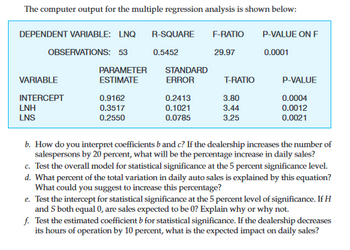Twentyfirst Century Electronics has discovered a theft problem at its warehouse and has decided to hire security guards. The firm wants to hire the optimal number of security guards. The following table shows how the number of security guards affects the number of radios stolen per week. Number of security guards Number of radios stolen per week 0 50 1 30 2 20 3 14 4 8 5 6 a- If each security guard is paid $200 a week and the cost of a stolen radio is $25, how many security guards should the firm hire? b. If the cost of a stolen radio is $25, what is the most the firm would be willing to pay
Twentyfirst Century Electronics has discovered a theft problem at its warehouse and has decided to hire security guards. The firm wants to hire the optimal number of security guards. The following table shows how the number of security guards affects the number of radios stolen per week.
|
Number of security guards
|
Number of radios stolen per week |
|
0 |
50 |
|
1 |
30 |
|
2 |
20 |
|
3 |
14 |
|
4 |
8 |
|
5 |
6 |
a- If each security guard is paid $200 a week and the cost of a stolen radio is $25, how
many security guards should the firm hire?
b. If the cost of a stolen radio is $25, what is the most the firm would be willing to pay
to hire the first security guard?
c. If each security guard is paid $200 a week and the cost of a stolen radio is $50, how
many security guards should the firm hire

Trending now
This is a popular solution!
Step by step
Solved in 2 steps

Why is the calculation of the total cost is wrong. The below is the right numbers but it is different from the solution given and if it comes down to this, will it be 2 or 3 security guards to employ to minimize the loss?
50*25 = 1250
30*25 = 750
20*25 = 500
14*25 = 350
Please provide clarification and provide the correct solutiob
4- The manager of Collins Import Autos believes the number of cars sold in a day(Q) depends on two factors: (1) the number of hours the dealership is open (H) and (2) the number of salespersons working that day (S ). After collecting data for two months (53 days), the manager estimates the following log-linear model:
Q = aHbSc
-----
a. Explain how to transform this log-linear model into a linear form that can be estimated using multiple regression analysis.
b. How do you interpret coefficients b and c? If the dealership increases the number of salespersons by 20 percent, what will be the percentage increase in daily sales?
c. Test the overall model for statistical significance at the 5 percent significance level.









